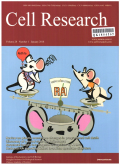- 钛学术文献服务平台 \
- 学术期刊 \
- 基础科学期刊 \
- 生物科学期刊 \
- 细胞研究(英文版)期刊 \
基本信息来源于合作网站,原文需代理用户跳转至来源网站获取
摘要:
Dear Editor,
Histone methylation is a reversible histone posttranslational modification that plays an important role in various chromatin-based processes,including chromatin structure remodeling,transcription,and DNA repair [1,2].LSD1 (also known as KDM1A) is the first identified histone lysine demethylase.It converts mono-or dimethylated histone H3 (H3K4mel/me2) to unmodified H3 [3].LSD1 is highly conserved in eukaryotes and plays important roles in various biological processes,such as development and tumorgenesis.LSD2 (also known as KDM1B or AOF1) is the only other mammalian paralogue of the LSD1 family.Similar to LSD1,LSD2 is also a histone H3K4mel/me2 demethylase [4-7].LSD1 has been shown to be enriched at promoter regions;in contrast,LSD2 mainly associates with the gene body regions of actively transcribed genes [5].LSD2 is highly expressed in oocytes,and is required for de novo DNA methylation of some imprinted genes,a function dependent on its H3K4 demethylase activity [4].Thus,LSD2 is an important player in epigenetic regulation and has functions distinct from those of LSD1.

推荐文章
期刊_丙丁烷TDLAS测量系统的吸收峰自动检测
带间级联激光器
调谐半导体激光吸收光谱
雾剂检漏 中红外吸收峰 洛伦兹光谱线型
不同盐度、温度及光照对漂浮浒苔生理生态的影响
浒苔
盐度
温度
光照
生理生态
期刊_联合空间信息的改进低秩稀疏矩阵分解的高光谱异常目标检测
高光谱图像
异常目标检测 低秩稀疏矩阵分解 稀疏矩阵 残差矩阵
内容分析
关键词云
关键词热度
相关文献总数
(/次)
(/年)
引文网络
引文网络
二级参考文献 (0)
共引文献 (0)
参考文献 (0)
节点文献
引证文献 (0)
同被引文献 (0)
二级引证文献 (0)
2013(0)
- 参考文献(0)
- 二级参考文献(0)
- 引证文献(0)
- 二级引证文献(0)
引文网络交叉学科
相关学者/机构
期刊影响力
细胞研究(英文版)
主办单位:
中国科学院上海生化细胞所
出版周期:
月刊
ISSN:
1001-0602
CN:
31-1568/Q
开本:
16开
出版地:
上海岳阳路319号中科院上海生命科学研究院31B,401室
邮发代号:
4-645
创刊时间:
1990
语种:
eng
出版文献量(篇)
2692
总下载数(次)
0
总被引数(次)
40708
期刊文献
相关文献
推荐文献
- 期刊分类
- 期刊(年)
- 期刊(期)
- 期刊推荐
力学
化学
地球物理学
地质学
基础科学综合
大学学报
天文学
天文学、地球科学
数学
气象学
海洋学
物理学
生物学
生物科学
自然地理学和测绘学
自然科学总论
自然科学理论与方法
资源科学
非线性科学与系统科学
细胞研究(英文版)2022
细胞研究(英文版)2021
细胞研究(英文版)2020
细胞研究(英文版)2019
细胞研究(英文版)2018
细胞研究(英文版)2017
细胞研究(英文版)2016
细胞研究(英文版)2015
细胞研究(英文版)2014
细胞研究(英文版)2013
细胞研究(英文版)2012
细胞研究(英文版)2011
细胞研究(英文版)2010
细胞研究(英文版)2009
细胞研究(英文版)2008
细胞研究(英文版)2007
细胞研究(英文版)2006
细胞研究(英文版)2005
细胞研究(英文版)2004
细胞研究(英文版)2003
细胞研究(英文版)2002
细胞研究(英文版)2001
细胞研究(英文版)2000
细胞研究(英文版)2013年第9期
细胞研究(英文版)2013年第8期
细胞研究(英文版)2013年第7期
细胞研究(英文版)2013年第6期
细胞研究(英文版)2013年第5期
细胞研究(英文版)2013年第4期
细胞研究(英文版)2013年第3期
细胞研究(英文版)2013年第2期
细胞研究(英文版)2013年第12期
细胞研究(英文版)2013年第11期
细胞研究(英文版)2013年第10期
细胞研究(英文版)2013年第1期

 免费查重
免费查重










